

Unavailable in your country. Jane Yolen, The Wild Hunt. Jane Yolen, The Wild Hunt (Harcourt Brace, 1995) Much snow is falling, winds roar hollowly, The owl hoots from the elder, Fear in your heart cries to the loving-cup: Sorrow to sorrow as the sparks fly upward.

The log groans and confesses: There is one story and one story only. Excerpt from the Robert Graves poem, 'To Juan on the Winter Solstice" (and the preface to The Wild Hunt) Ahhh, but is there but 'one story and one story only' or are there as many tales as there are tellers? In this novel lies the answer (possibly) to that question. Catholic Encyclopedia (1913)/St. William (1) - Wikisource, the free online library. (WILLIAM FITZHERBERT, also called WILLIAM OF THWAYT).
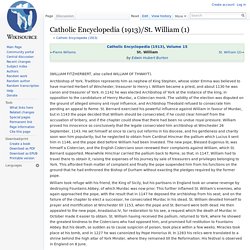
Archbishop of York. Tradition represents him as nephew of King Stephen, whose sister Emma was believed to have married Herbert of Winchester, treasurer to Henry I. William became a priest, and about 1130 he was canon and treasurer of York. In 1142 he was elected Archbishop of York at the instance of the king, in opposition to the candidature of Henry Murdac, a Cistercian monk.
The validity of the election was disputed on the ground of alleged simony and royal influence, and Archbishop Theobald refused to consecrate him pending an appeal to Rome. Catholic Encyclopedia (1913)/Walter of St-Victor - Wikisource, the free online library. Mystic philosopher and theologian of the twelth century.
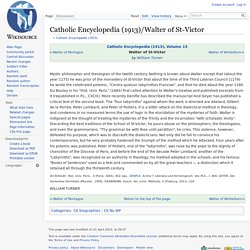
Nothing is known about Walter except that (about the year 1175) he was prior of the monastery of St-Victor that about the time of the Third Lateran Council (1179) he wrote the celebrated polemic, "Contra quatuor labyrinthos Franciae", and that he died about the year 1180. Du Boulay in his "Hist. Univ. Paris. " (1665) first called attention to Walter's treatise and published excerpts from it (republished in P.L., CXCIX). Roman de Brut. Arthur finds a giant roasting a pig.
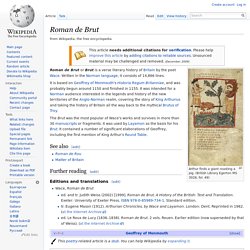
(British Library Egerton MS 3028, fol. 49) Roman de Brut or Brut is a verse literary history of Britain by the poet Wace. Written in the Norman language, it consists of 14,866 lines. It is based on Geoffrey of Monmouth's Historia Regum Britanniae, and was probably begun around 1150 and finished in 1155. It was intended for a Norman audience interested in the legends and history of the new territories of the Anglo-Norman realm, covering the story of King Arthurius and taking the history of Britain all the way back to the mythical Brutus of Troy.
Gilbertine Order. Seal of the Master of the Order of Sempringham The Gilbertine Order of Canons Regular was founded around 1130 by Saint Gilbert in Sempringham, Lincolnshire, where Gilbert was the parish priest.

It was the only completely English religious order and came to an end in the 16th century at the time of the Dissolution of the Monasteries. John of Worcester. King Henry I's Dream in the Chronicle.
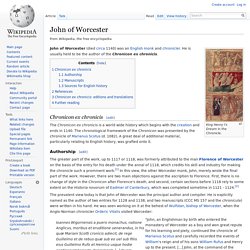
John of Worcester (died circa 1140) was an English monk and chronicler. He is usually held to be the author of the Chronicon ex chronicis. Chronicon ex chronicis[edit] The Chronicon ex chronicis is a world wide history which begins with the creation and ends in 1140. Herbert_MartinOfTours.pdf. Viking Pirates and Christian Princes: Dynasty, Religion, and Empire in the ... - Benjamin T. Hudson.
The Land of Cockaygne: Introduction. Saint Cadocs Church Caerleon by Eija Kennerley from Gwent Local History. Gwent Local History No. 50, Spring 1981 Saint Cadoc's Church, Caerleon by Eija Kennerley.
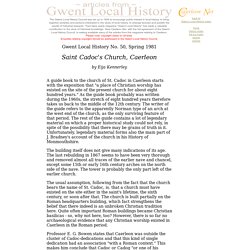
Who's Who in Medieval History - Index for the Years 1101-1200. Geoffrey of Monmouth, The History of the Kings of Britain. Geoffrey ap Arthur, later known as Geoffrey of Monmouth, completed this work in 1136.
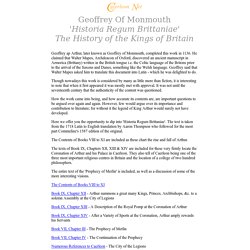
He claimed that Walter Mapes, Archdeacon of Oxford, discovered an ancient manuscript in Armorica (Brittany) written in the British tongue i.e. the Celtic language of the Britons prior to the arrival of the Saxons and Danes, something like the Welsh language. Geoffrey said that Walter Mapes asked him to translate this document into Latin - which he was delighted to do. Though nowadays this work is considered by many as little more than fiction, it is interesting to note that when it first appeared it was mostly met with approval. It was not until the seventeenth century that the authenticity of the content was questioned. How the work came into being, and how accurate its contents are, are important questions to be argued over again and again.
Browse All : Images from 12th century, beginning - ODL. The annals of Roger de Hoveden : Comprising the... Mandeville's travels : the Egerton version / from the edition by George F. Warner. A History of Western Philosophy 2.9. Jacques Maritain Center : A History of Western Philosophy Vol.

II / by Ralph McInerny Introduction. Manuscript Art. William of Malmesbury. William of Malmesbury was born in Wiltshire in about 1095.
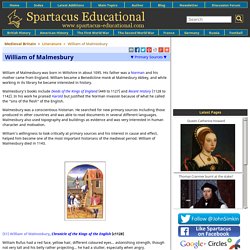
His father was a Norman and his mother came from England. William became a Benedictine monk at Malmesbury Abbey, and while working in its library he became interested in history. Malmesbury's books include Deeds of the Kings of England (449 to 1127) and Recent History (1128 to 1142). Williamofmalmesb1847will_bw.pdf. The English Anarchy of the 12th Century. Matilda was fortunate enough to benefit from yet another quarrel between Stephen and Earl Ranulf of Chester. The earl was engaged in a dispute with the king over his birthright, Carlisle. When Raulf revolted against Stephen in 1140, he narrowly escaped capture and fled to Matilda's side. Old English Literature and the Old Testament. Cathedrals, Communities and Conflict in the Anglo-Norman World. Government, Religion and Society in Northern England, 1000-1700. Conquest, Anarchy and Lordship: Yorkshire, 1066-1154 - Paul Dalton. Saints and their Communities : Miracle Stories in Twelfth-Century England ... - Simon Yarrow.
The Long Twelfth-Century View of the Anglo-Saxon Past. Essays in Anglo-Saxon History - James Campbell. The English in the Twelfth Century: Imperialism, National Identity, and ... - John Gillingham. Historical Writing in England: c. 500 to c. 1307 - Antonia Gransden. Henry of Scotland, Earl of Huntingdon. (circa 1115 -1152) Henry of Scotland, Earl of Huntingdon was the son of King David I of Scotland. Through his mother Maud, 2nd Countess of Huntingdon, he was the grandson of the Saxon Waltheof, Earl of Northumbria and Huntingdon, who was beheaded by William the Conqueror in 1075 and his wife Judith of Lens, the daughter of Lambert II, Count of Lens and Adelaide of Normandy, Countess of Aumale. Henry was named after his uncle, King Henry I of England, who had married his paternal aunt Edith of Scotland. He was described as handsome in body and virtuous of life, beloved by all, devout towards God and most compassionate to the poor.
He was granted Doncaster and the lordship of Carlisle, the honour and earldom of Huntingdon in around 1136. Siward Earl of Northumbria. The larger than life figure of Siward, earl of Northumbria first appears on the pages of history in the year 1033, when he stood as a witness in a charter by King Canute for Archbishop Ælfric of York. Siward is generally considered to be of Danish stock, the 'Vita Ædwardi Regis', which was compiled by an anonymous author circa 1067 and commissioned by Queen Edith, the widow of King Edward the Confessor, records that Siward's nickname was ‘Digri’, or ‘Digara’, deriving from the Danish Diger meaning ‘the Stout’, or ‘the Strong’.
The biography of Siward's son Waltheof, states that Siward was the son of a Scandinavian earl named Bjorn. Transactions of the Royal Historical Society - Abstract - Presidential Address: The People of Britain and Ireland, 1100–1400, 1.Identities. The Treasury of Basel Cathedral. The History of France: (Ancient Gaul) - Parke Godwin. Heretics and Scholars in the High Middle Ages, 1000-1200 - Heinrich Fichtenau. The Uses of the Past in the Early Middle Ages. In Samuel's Image: Child Oblation in the Early Medieval West - Mayke De Jong.
The Uses of Literacy in Early Mediaeval Europe. Medieval Goliards: The Boorish Scholars. Those secular medieval musicians that shook up monophony I’ve decided to submit essays from my past studies as writing samples. If you would like receive a list of resources, please reach out to me on twitter (@trevormolag) or elsewhere. This was one of my first essays from my time at the University of Lethbridge. (2011) Monophonic music is a type of music that contains the simplest melody — one without any sort of harmony. It is played one note after the other, and was the principal type of music played in the early medieval ages of Western Europe. History as a Visual Art in the Twelfth-Century Renaissance - Karl F. Morrison. The History of Grammar in the Middle Ages, Collected Papers. With a select bibliography, and indices - Google Play. Illustrations of the history of mediaeval thought, in the departments of theology and ecclesiastical politics - Google Play.
A Bloody Good Read:Where writers and readers of historical thrillers talk shop: Dominic Selwood: Turning History Into Thrills. By Nancy Bilyeau I learned about the fiction of Dominic Selwood by reading a piece of riveting nonfiction--an article in the Daily Telegraph titled "How a Protestant Spin Machine Hid the Truth About the English Reformation. " (Read it here.) In the nearly 10 years I've been researching England's break from Rome, the backdrop to my historical thrillers, I'd come to many of the same conclusions about Henry VIII and Cromwell's actual agenda as this writer. I "etroduced" myself on twitter, and soon learned that apart from being a historian and former criminal solicitor, Dominic too was writing fiction.
His thriller, set in modern times, is called The Sword of Moses. Hybrid Atlantics: Future Directions for the History of the Atlantic World - Cañizares-Esguerra - 2013 - History Compass. Illustrations of the history of mediaeval thought, in the departments of theology and ecclesiastical politics - Google Play. Unavailable in your country. Thierry, Count of Flanders. William Clito. Tostig Godwinson. Category:1140s deaths. Family tree of the German monarchs. Henry III, Holy Roman Emperor. Salian dynasty. Siward, Earl of Northumbria. David I of Scotland. Duncan II of Scotland.
Pope Innocent II. The Anglo-Saxon Chronicle - PREPARER'S NOTE: World Wide School Library - History-European-Heimskringla. Ingibiorg Finnsdottir. Mary of Scotland, Countess of Boulogne. Cressing Temple. Battle of Wilton. William Martel. Battle of Wilton. Battle of the Standard. Category:Battles of The Anarchy. Timeline of Medieval Britain. The Council, Siege and Rout of Winchester (1141) Matilda of Boulogne. Rout of Winchester. Battle of Lincoln (1141) Fulk, King of Jerusalem.
Category:1143 deaths. Miles of Gloucester, 1st Earl of Hereford. Anselm of Havelberg: Deeds Into Words in the Twelfth Century - Jay Terry Lees. Category:1144 deaths. Conrad I of Salzburg. Margaret of Austria, Queen of Bohemia. Siege of Weinsberg. Category:12th-century conflicts. Category:12th-century conflicts. Norman conquest of southern Italy. Battle of Dorylaeum (1097) Paul and Erlend Thorfinnsson. Kingdom of Sicily. Philip of Swabia.
6 Legendary Mercenary Armies — HISTORY Lists. Is not available. First text in Middle English? Historical-Background-and-Biographies. Medieval Church Treasures. Heroes of the Old Testament: Picturing the Story of David and Goliath. Hemingway’s Twentieth-Century Medievalism. St Margaret’s Chapel in Edinburgh Castle – The Hazel Tree. Englishhistoryauthors.blogspot.gr/2014/09/richard-i-in-holy-land.html.